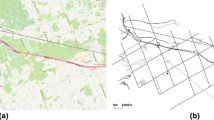Abstract
Mobile terminal position location, tracking and prediction are becomingimportant areas of research for advanced cellular communications.Methods for mobile terminal location are evaluated using simulations. To obtain accurate simulation results, the simulation environment and terminalmotion model must be as realistic as possible. This paper describes a simulation system for mobile terminals located within vehicles in dense urban environments. These are the mobiles with the greatest need for locationpredictions in the environments of greatest interest to network providers. Theradio propagation model is based on well known multipath radio propagationmodels. The motion model combines an accurate kinematic model for vehicular motion with a driver decision model to mimic human driving decisions.Simulatedmobile terminal motion tracks are presented, showing how realistic motionsare generated.
Similar content being viewed by others
References
F.H. Blecher, “Advanced Mobile Phone Service”, IEEE Transactions on Vehicular Technology, Vol. VT-29, No. 2, pp. 238–244, 1980.
L. Jorguseski, E. Fledderus, J. Farserotu and R. Prasad, “Radio Resource Allocation in Third-generation Mobile Communication Systems”, IEEE Communications Magazine, Vol. 39, No. 2, pp. 117–123, 2001.
G.S. Kuo, P.C. Ko and M.L. Kuo, “A Probabilistic Resource Estimation and Semi-reservation Scheme for Flow-oriented Multimedia Wireless Networks”, IEEE Communications Magazine, Vol. 39, No. 2, pp. 135–141, 2001.
J.J. Caffery, Jr. and G.L. Stüber, “Subscriber Location in COMA Cellular Networks”, IEEE Transactions on Vehicular Technology, Vol. 47, No. 2, pp. 406–416, 1998.
M. Hellebrandt and R. Mathar, “Location Tracking of Mobiles in Cellular Radio Networks”, IEEE Transactions on Vehicular Technology, Vol. 48, No. 5, pp. 1558–1562, 1999.
Z. Salcic, “GSM Mobile Station Location Using Reference Stations and Artificial Neural Networks”, Wireless Personal Communications, Vol. 19, pp. 205–226, 2001.
I. Jami, M. Ali and R.F. Ormondroyd, “Comparison ofMethods of Locating and Tracking CellularMobiles”, in IEE Colloquium on Novel Methods of Location and Tracking of Cellular Mobiles and Their System Applications, 1999, pp. 1/1–1/6.
R.R. Collman, “Evaluation of Methods for Determining the Mobile Traffic Distribution in Cellular Radio Networks”, IEEE Transactions on Vehicular Technology, Vol. 50, No. 6, pp. 1629–1635, 2001.
J.D. Parsons, The Mobile Radio Propagation Channel, Pentech Press, 1992.
W.C.Y Lee, Mobile Communications Engineering, McGraw-Hill, Toronto, second edition, 1998.
ETSI, “Universal Mobile Telecommunications Systems (UMTS); Selection Procedures for the Choice of Radio Transmission Technologies of the UMTS (UMTS 30.02 Version 3.2.0)”, Technical Report, European Telecommunications Standards Institute, 1998.
S. Ichitsubo, T. Furono, T. Taga and R. Kawasaki, “Multipath Propagation Model for Line-of-sight Street Microcells in Urban Area”, IEEE Transactions on Vehicular Technology, Vol. 49, No. 2, pp. 422–427, 2000.
E. Dahlman, B. Gudmundson, M. Nilsson and J. Sköld, “UMTS/IMT-2000 Based on Wideband CDMA”, IEEE Communications Magazine, Vol. 36, No. 9, pp. 70–80, 1998.
S. Haykin, Digital Communications, John Wiley & Sons, Inc., Toronto, Ontario, Canada, 1988.
A.J. Viterbi, CDMA: Principles of Spread Spectrum Communication, Addison-Wesley Publishing Company, Don Mills, Ontario, 1995.
H.S.H Gombachika and O.K. Tonguz, “Influence of Multipath Fading and Mobile Unit Velocity on the Performance of PN Tracking in CDMA Systems”, in IEEE Vehicular Technology Conference, May 1997, pp. 2206–2209.
R.D.J. Van Nee, “Spread-spectrum Code and Carrier Synchronization Errors Caused by Multipath and Interference”, IEEE Transactions on Aerospace and Electronic Systems, Vol. 29, No. 4, pp. 1359–1365, 1993.
S. Takezono, H. Minamoto and K. Tao, “Two-dimensional Motion of Four-wheel Vehicles”, Vehicle System Dynamics, Vol. 32, pp. 441–458, 1999.
C.-F. Lin, A.G. Ulsoy and D.J. LeBlanc, “Vehicle Dynamics and External Disturbance Estimation for Vehicle Path Predicition”, IEEE Transactions on Control Systems Technology, Vol. 8, No. 3, pp. 508–518, 2000.
W.D. Glauz and D.W. Harwood, “Chapter 3: Vehicles”, in J.L. Pline (ed.), Traffic Engineering Handbook, Institution of Transportation Engineers, Washington, D.C., 5th edition, 1999.
M.D. Yacoub, Foundations of Mobile Radio Engineering, CRC Press, Inc., Boca Raton, Florida, 1993.
C. Bettstetter, “Smooth is Better than Sharp: A Random Mobility Model for Simulation of Wireless Networks”, in ACM International Workshop on Modelling, Analysis, and Simulation of Wireless and Mobile Systems, Rome, Italy, July 2001, pp. 19–27.
B. Jabbari, Y. Zhou and F. Hillier, “Simple Random Walk Models for Wireless Terminal Movements”, in Vehicular Technology Conference, Houston, Texas, May 1999, pp. 1784–1788.
K.-S. Kim, M.-H. Cho and K.-R. Cho, “A Simple Analytic Approach for the Cell Sojourn Time in the Gaussian Distributed Mobile Velocity”, IEICE Transactions on Communications, Vol. E83-B, No. 5, pp. 1148–1151, 2000.
H. Xie and D.J. Goodman, “Mobility Models and Biased Sampling Problem”, in International Conference on Universal Personal Communications, Ottawa, Ontario, October 1999, pp. 803–807.
M.M. Zonoozi and P. Dassanayake, “A Novel Method for Tracing Mobile Users in a Cellular Mobile Communication System”, Wireless Personal Communications, Vol. 4, pp. 185–205, 1997.
T. Liu, P. Bahl and I. Chlamtac, “Mobility Modeling, Location Tracking, and Trajectory Prediction in Wireless ATM Networks”, IEEE Journal on Selected Areas in Communications, Vol. 16, No. 6, pp. 922–936, 1998.
E. Aleman-Llanes, D. Munoz-Rodriguez and C. Molina, “PCS Subscribers Mobility Modelling Using Fractional Brownian Motion (FBM)”, European Transactions on Communication, Vol. 11, No. 2, pp. 191–198, 2000.
C.F Daganzo, Fundamentals of Transportation and Traffic Operations, Elsevier Science Inc., London, U.K., 1997.
A. Leon-Garcia, Probability and Random Processes for Electrical Engineering, Addison-Wesley Publishing Company, Don Mills, Ontario, second edition, 1994.
K. Ogata, Discrete-Time Control Systems, Prentice Hall, Englewood Cliffs, N.J., 1995.
Author information
Authors and Affiliations
Rights and permissions
About this article
Cite this article
McGuire, M., Plataniotis, K. & Venetsanopoulos, A. Environment and Movement Model for Mobile Terminal Location Tracking. Wireless Personal Communications 24, 483–505 (2003). https://doi.org/10.1023/A:1023282928706
Issue Date:
DOI: https://doi.org/10.1023/A:1023282928706




